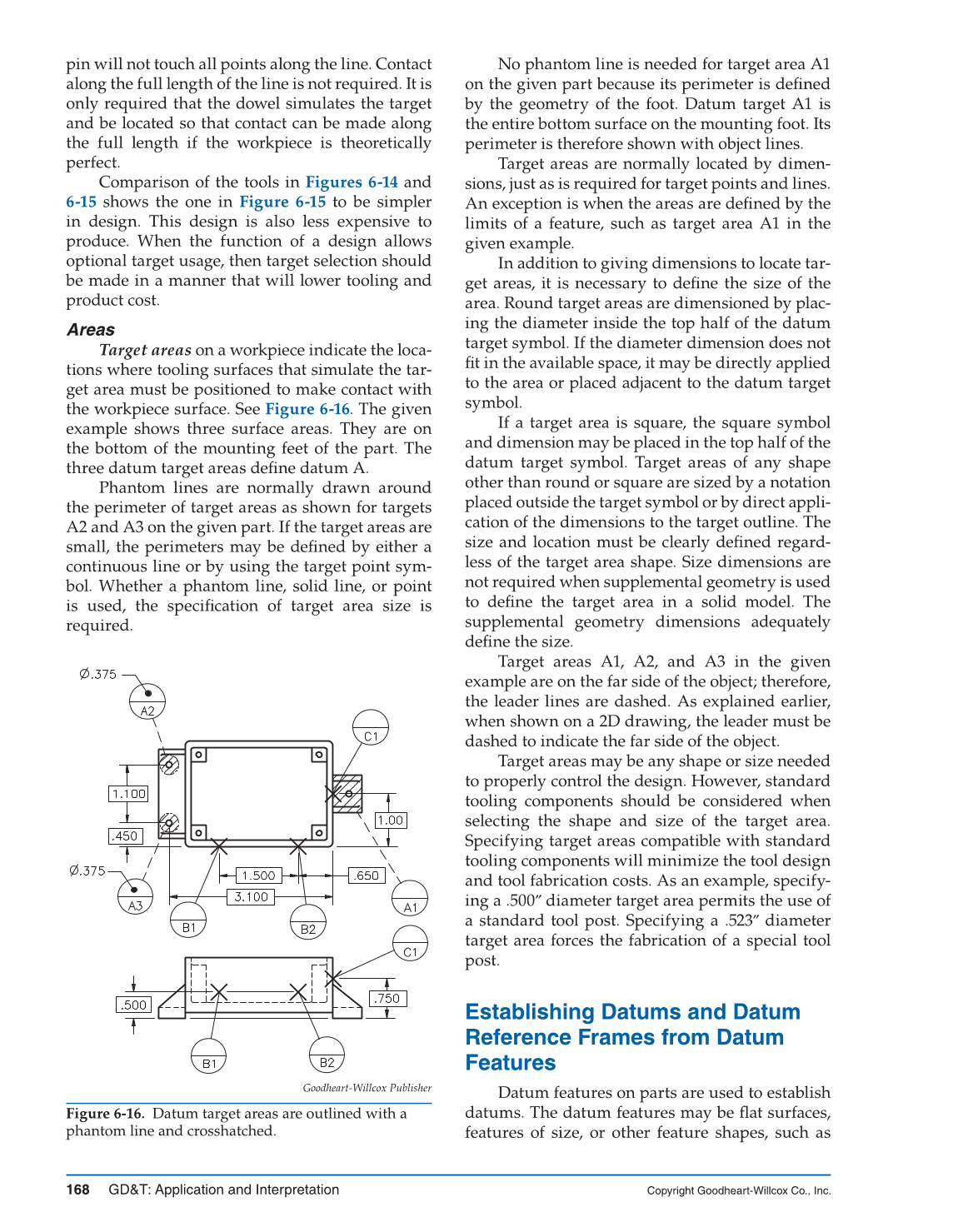168 GD&T: Application and Interpretation
Copyright Goodheart-Willcox Co., Inc.
pin will not touch all points along the line. Contact
along the full length of the line is not required. It is
only required that the dowel simulates the target
and be located so that contact can be made along
the full length if the workpiece is theoretically
perfect.
Comparison of the tools in Figures 6-14 and
6-15 shows the one in Figure 6-15 to be simpler
in design. This design is also less expensive to
produce. When the function of a design allows
optional target usage, then target selection should
be made in a manner that will lower tooling and
product cost.
Areas
Target areas on a workpiece indicate the loca-
tions where tooling surfaces that simulate the tar-
get area must be positioned to make contact with
the workpiece surface. See Figure 6-16. The given
example shows three surface areas. They are on
the bottom of the mounting feet of the part. The
three datum target areas defi ne datum A.
Phantom lines are normally drawn around
the perimeter of target areas as shown for targets
A2 and A3 on the given part. If the target areas are
small, the perimeters may be defi ned by either a
continuous line or by using the target point sym-
bol. Whether a phantom line, solid line, or point
is used, the specifi cation of target area size is
required.
No phantom line is needed for target area A1
on the given part because its perimeter is defi ned
by the geometry of the foot. Datum target A1 is
the entire bottom surface on the mounting foot. Its
perimeter is therefore shown with object lines.
Target areas are normally located by dimen-
sions, just as is required for target points and lines.
An exception is when the areas are defi ned by the
limits of a feature, such as target area A1 in the
given example.
In addition to giving dimensions to locate tar-
get areas, it is necessary to defi ne the size of the
area. Round target areas are dimensioned by plac-
ing the diameter inside the top half of the datum
target symbol. If the diameter dimension does not
fi t in the available space, it may be directly applied
to the area or placed adjacent to the datum target
symbol.
If a target area is square, the square symbol
and dimension may be placed in the top half of the
datum target symbol. Target areas of any shape
other than round or square are sized by a notation
placed outside the target symbol or by direct appli-
cation of the dimensions to the target outline. The
size and location must be clearly defi ned regard-
less of the target area shape. Size dimensions are
not required when supplemental geometry is used
to defi ne the target area in a solid model. The
supplemental geometry dimensions adequately
defi ne the size.
Target areas A1, A2, and A3 in the given
example are on the far side of the object; therefore,
the leader lines are dashed. As explained earlier,
when shown on a 2D drawing, the leader must be
dashed to indicate the far side of the object.
Target areas may be any shape or size needed
to properly control the design. However, standard
tooling components should be considered when
selecting the shape and size of the target area.
Specifying target areas compatible with standard
tooling components will minimize the tool design
and tool fabrication costs. As an example, specify-
ing a .500″ diameter target area permits the use of
a standard tool post. Specifying a .523″ diameter
target area forces the fabrication of a special tool
post.
Establishing Datums and Datum
Reference Frames from Datum
Features
Datum features on parts are used to establish
datums. The datum features may be fl at surfaces,
features of size, or other feature shapes, such as
Goodheart-Willcox Publisher
Figure 6-16. Datum target areas are outlined with a
phantom line and crosshatched.
